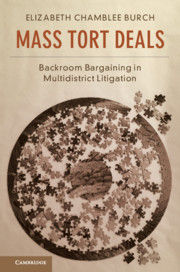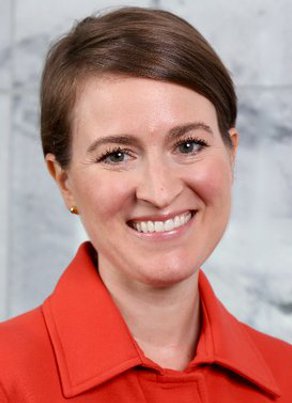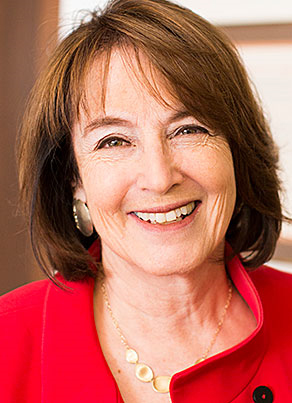Mass Tort Deals: Must-Read Interviews for a Must-Read Book
 In 1965, Ralph Nader published Unsafe at Any Speed, an exposé on automobile safety, and since its publication, consumer faith in product safety has never been the same.
In 1965, Ralph Nader published Unsafe at Any Speed, an exposé on automobile safety, and since its publication, consumer faith in product safety has never been the same.
The early efforts of Nader and his legion of young lawyers and researchers—who came to be known as Nader’s Raiders—spurred the growth of products liability litigation. Nader gave consumers and their counsel a reason to go to court: they challenged the safety of products from cars to cribs, and the courtroom provided the level playing field where even the little guy could be heard and get justice.
Now, 50 years later, a law professor at the University of Georgia is exposing impropriety in a system—known as multidistrict litigation, or MDL—that is designed to handle these types of cases.
In her 2019 book Mass Tort Deals: Backroom Bargaining in Multidistrict Litigation, Professor Elizabeth Chamblee Burch blows the whistle on MDL. She writes about a virtually unregulated system driven by deals between a limited group of plaintiff and defense lawyers involving tens of thousands of plaintiffs. Burch’s work is not just based on empirical data; she writes about victims of car accidents, misbranded drugs, and defective medical devices whose cases—purportedly consolidated only for pretrial proceedings—are resolved by court-appointed lead counsel through global settlements that give defendants finality and plaintiffs little choice but to accept the offer. Burch also raises concerns about a system that promotes, indeed at times coerces, settlements over the transparent litigation that has historically driven regulation and made products safer.
If one were to think her concerns involve only a small fraction of federal court litigation, think again. Burch writes that “from 2002 to 2017, MDL jumped from 16 to 37% of the federal court’s pending case load,” with 95 percent of those cases in the products liability arena.
 The system that Burch writes about had its origins in the early 1960s, when the federal courts were flooded with nearly 2,000 lawsuits stemming from a nationwide conspiracy to fix the prices of equipment used in the transmission of electricity. With guidance from Chief Justice Earl Warren, who created a Coordinating Committee of Multidistrict Litigation, a process was created to drive efficiencies in the litigation of these cases. The work of Warren and the committee’s chair, Alfred P. Murrah—then Chief Judge of the Tenth Circuit—paved the way for the passage of the MDL statute, 28 U.S.C. § 1407, in 1968. That statute provides for the coordination for pretrial purposes of civil actions involving “one or more common questions of fact.” Cases filed anywhere in the federal court system can be transferred to a single district for pretrial purposes. The MDL statute is short and—in contrast to Federal Rule of Civil Procedure 23, which addresses class actions—provides no standards for the appointment of counsel, class representatives, or for the approval of settlements.
The system that Burch writes about had its origins in the early 1960s, when the federal courts were flooded with nearly 2,000 lawsuits stemming from a nationwide conspiracy to fix the prices of equipment used in the transmission of electricity. With guidance from Chief Justice Earl Warren, who created a Coordinating Committee of Multidistrict Litigation, a process was created to drive efficiencies in the litigation of these cases. The work of Warren and the committee’s chair, Alfred P. Murrah—then Chief Judge of the Tenth Circuit—paved the way for the passage of the MDL statute, 28 U.S.C. § 1407, in 1968. That statute provides for the coordination for pretrial purposes of civil actions involving “one or more common questions of fact.” Cases filed anywhere in the federal court system can be transferred to a single district for pretrial purposes. The MDL statute is short and—in contrast to Federal Rule of Civil Procedure 23, which addresses class actions—provides no standards for the appointment of counsel, class representatives, or for the approval of settlements.
With Supreme Court rulings on class actions in the late 1990s making class certification more difficult for plaintiffs, mass tort actions—rolled up into the MDL system—became the go-to method for handling matters that in yesteryear might have been addressed through the more regulated class-action system. The big plaintiff firms could still litigate massive actions and the defense lawyers could still engineer settlements giving their clients global peace.
Yet, the MDL statute addresses only pretrial matters—not settlement; not global peace; not provisions for opting out; not the appointment of counsel, the compensation of counsel, or the confidentiality of and use of materials discovered in litigation. It is here that Burch does a masterful job of exposing the “Mass Tort Deals” that have evolved from an unregulated system.
To get a better sense of the problem, I posed questions to Professor Burch and Judge Nancy Gertner, who retired from the federal bench in 2011 and now teaches at Harvard Law. My interviews are below.
Judge Gertner, do we have a real problem with the MDL process and how do you view that problem from having been on the bench?
 The problem is the classic one: rules and transparency. There were no clear rules with respect to who is assigned an MDL. There is no blind draw, no concrete set of procedures. After I complained about the asbestos MDL shortly after I got on the bench—late 1990s—I was never assigned a case again. My complaint was that the MDL judge, Judge [Charles] Weiner of Philadelphia, was simply dismissing the cases “subject to their being reopened by motion.” The dismissals were contrived, done for the purpose of showing that the cases were moving. I finally got an MDL when Judge Robert Keeton died and my court assigned me to one that had been assigned to him. In the last year I was on the bench, I drew a civil rights case that was headed for the MDL court. My case was the first filed, a second was in Chicago, a third in San Francisco. All of us were up to date, willing to take on the case. It was assigned to neither of us; it went to a judge in Memphis who was on the committee.
The problem is the classic one: rules and transparency. There were no clear rules with respect to who is assigned an MDL. There is no blind draw, no concrete set of procedures. After I complained about the asbestos MDL shortly after I got on the bench—late 1990s—I was never assigned a case again. My complaint was that the MDL judge, Judge [Charles] Weiner of Philadelphia, was simply dismissing the cases “subject to their being reopened by motion.” The dismissals were contrived, done for the purpose of showing that the cases were moving. I finally got an MDL when Judge Robert Keeton died and my court assigned me to one that had been assigned to him. In the last year I was on the bench, I drew a civil rights case that was headed for the MDL court. My case was the first filed, a second was in Chicago, a third in San Francisco. All of us were up to date, willing to take on the case. It was assigned to neither of us; it went to a judge in Memphis who was on the committee.
If the MDL process were “merely” procedural, it would be one thing. But the decisions made by the MDL judge profoundly affected the substantive outcomes of these cases. Under the circumstances, the failure to have a transparent judicial assignment process is critical to the fairness of the proceeding.
Professor Burch, your book raises ethical issues regarding the MDL process. Why has there not been more of an outcry?
All of the primary stakeholders—plaintiffs’ lawyers, corporate defendants, defense attorneys, and yes, judges—benefit from settlements. And it’s in aggregate settlements where ethical issues arise most prominently. To give corporate defendants the closure they demand, some “settlements” (deals between defendants and plaintiffs’ attorneys) require plaintiffs’ lawyers to recommend the settlement uniformly to all their clients and then some take the extraordinary step of requiring lawyers to withdraw from representing clients who refuse to settle. That doesn’t leave much room for genuine consent.
Those who are most impacted by ethical violations are the plaintiffs, many of whom are severely injured and have neither the time nor the resources to make a stink. In a world of repeat players, they are the one-shotters, the ones who need and deserve the most protection because their voices are so rarely heard. But therein lay the crux of the principal–agent problem: if it’s in the lawyer’s best interest to flout the rules and get the deal done, there will be no outcry, only silence.
Judge Gertner, from your vantage point, why has there not been more of an outcry about the problem?
The question is who is likely to complain and to whom? Judges are not complaining; the assignments are a plum for the Court, entitling the judge to attend a yearly conference in Palm Beach. And the skewed assignment process is usually not apparent. (It was in my case.) The lawyers are not complaining. Candidly, many of the lawyers in MDL case are competing for lead counsel; the last thing they want to do is rock the boat.
Professor Burch, many of the MDLs involve drugs or medical devices. Are the issues you raise in your book ultimately impacting healthcare standards?
The mass-torts plaintiffs’ bar is a last resort, a failsafe of sorts, for when medical drugs or devices come on the market that do more harm than good. So, yes, there is a feedback loop from the courts to healthcare and vice versa.
The FDA regulates everything from tainted spinach to cosmetics to pet food. It can’t and won’t catch everything. There will be drugs and devices on the market that shouldn’t be. We would hope that litigation opens a window into the processes that allowed that to happen so that drug and device companies would avoid those kinds of mistakes in the future. But, if the past is any indicator, the profit motive is a very strong one to overcome.
Judge Gertner, what is the process for fixing the problems?
The authorizing legislation and rules should be redone. There ought to be rules with respect to the assignment of judges—a random draw, a set of principles. And the rules along with judicial training need to make clear that some cases should not be settled; the premium in the MDL is not—as it was supposed to be—providing a mechanism for shared discovery, with a trial to follow in the jurisdictions from which the cases came. The premium is on resolving the case.
Professor Burch, who needs to read your book, and what needs to be done to begin to fix the problems you identify?
I hope the book will appeal broadly to policymakers, judges, lawyers, and plaintiffs alike. It’s empirically based, but not stodgy. I aimed to make it accessible to a diverse group—from insiders who operate in this world daily to those who are injured and experiencing the judicial system firsthand.
As for a fix, there is no single, silver bullet. But there are many things that can improve it and judges can implement the changes and reforms I suggest without waiting for rule changes or legislation. I devote an entire chapter to proposals, but I’ve boiled the key principles down to the following:
- Appoint lead plaintiffs’ lawyers based on the same principles of adequate representation that we see in class actions. In doing so, judges should invite applications and think about building the best team by seeking cognitive diversity—people with a diverse set of tools and skills, who approach problems differently.
- Value dissent among lawyers and create outlets for it. As plaintiffs’ aims and preferences differ, dissenters can challenge the status quo and inject undisclosed information into the discussion. Dissenters can thereby act as a failsafe (but not a substitute) for adequate representation on key motions.
- Tie plaintiffs’ attorneys’ common-benefit fees (the fees they are paid for their work on behalf of the group as a whole rather than their individual clients) to plaintiffs’ actual outcome rather than to the “sticker price” of the settlement fund. Begin by subtracting litigation costs and administrative fees from the gross settlement amount so that lawyers don’t profit from added expense. Then tailor awards to groups of lawyers based on quantum meruit. If there’s a group of non-lead lawyers who do little but advertise and freeride on leaders’ efforts, then taxing them with a higher percentage common-benefit fee might be appropriate. Conversely, if lawyers develop and try state court cases on their own, judges should reduce common-benefit fees for those lawyers to incentivize them to develop cases on the merits.
- Empower plaintiffs to weigh in on their settlement awards. Awarding fees on a quantum meruit basis gives judges the authority to hear about the benefits of any deal from those who are most affected. Many plaintiffs want an opportunity to be heard, even if it’s just a chance to submit a letter to the judge. Some feel victimized not only by the corporate defendant but by the litigation process itself. If plaintiffs are receiving less than 50% of a settlement award, that should be a huge red flag for the judge.
- Remand cases episodically. When leaders decide which cases they’re going to develop and which ones they aren’t, the ones that won’t benefit from multidistrict litigation centralization shouldn’t be waylaid by the MDL process. Likewise, if discovery reveals that a block of cases is no longer benefitting from centralization or if there is a global settlement that clients don’t want to accept, judges shouldn’t be hesitant to remand those cases to the federal courts from which they came. This gives plaintiffs the ability to credibly threaten trial and the corporate defendant the opportunity to demand case-specific proof.
And now my take. Our rule of law is a work in progress. That’s what makes is special. It is a system that welcomes critique and improvement. For NITA lawyers and jurists who champion the rule of law, the Burch book is a must-read. It is a catalyst for an open dialogue and undoubtedly procedural changes in the way many of these mass tort cases are adjudicated.
Reuben Guttman is a founding partner of Guttman, Buschner & Brooks, PLLC, in Washington, D.C. Read more of his On the Rule of Law columns here.
